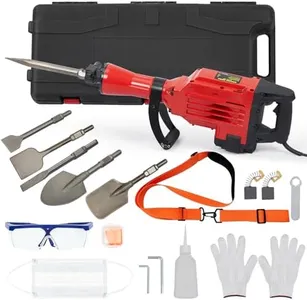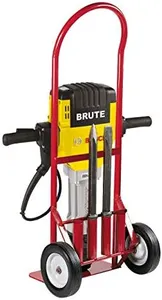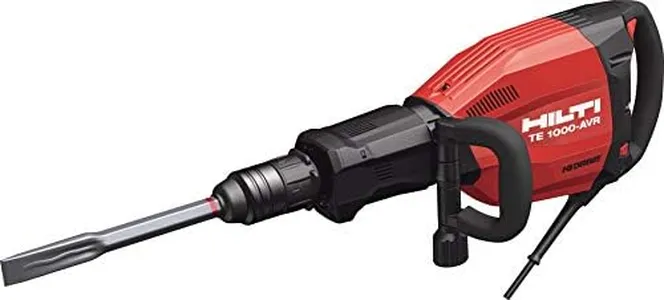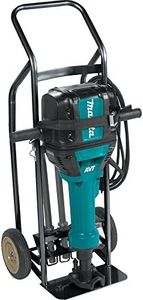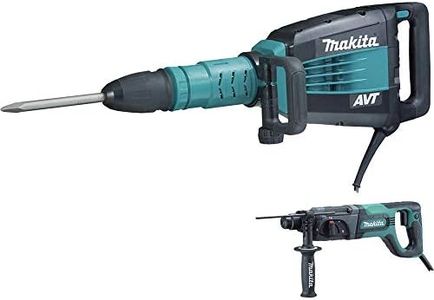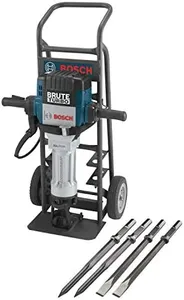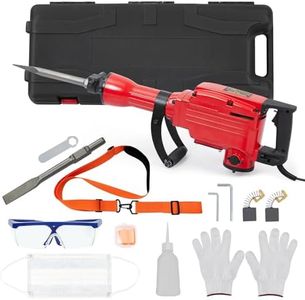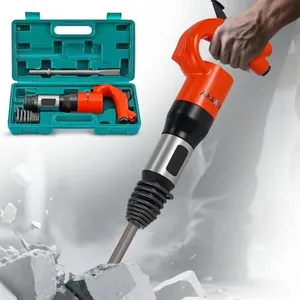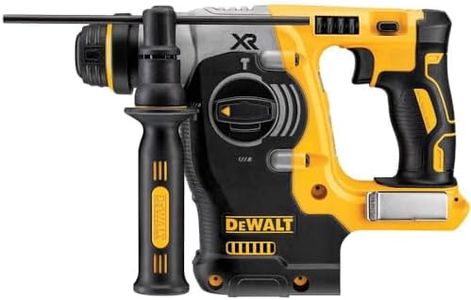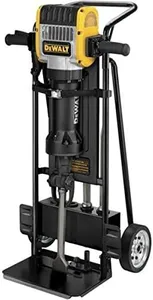10 Best Electric Jack Hammers 2025 in the United States
Our technology thoroughly searches through the online shopping world, reviewing hundreds of sites. We then process and analyze this information, updating in real-time to bring you the latest top-rated products. This way, you always get the best and most current options available.

Our Top Picks
Winner
BOSCH BH2760VCB 120-Volt 1-1/8 Brute Breaker Hammer with Basic Cart
Most important from
83 reviews
The BOSCH BH2760VCB Brute Breaker Hammer is a robust and powerful tool designed for heavy-duty tasks like foundation work and pipe laying. It delivers an impressive 35 ft.-lbs. of impact energy, which is more than enough for even the toughest jobs. Weighing 63 pounds, it’s relatively manageable for its class, though still requires some muscle to operate.
Its standout feature is the Active Vibration Control system, which significantly reduces vibration and enhances user comfort through an ergonomic, shock-absorbing handle. This makes prolonged use more manageable and less tiring. The hammer includes Bosch’s Service Minder Brush System, which helps in maintaining the tool by automatically shutting it off for brush replacement or preventative maintenance. This ensures less downtime and a longer lifespan for the tool.
Additionally, the grease-packed gearbox and hammer mechanism add to its durability by eliminating the need for constant lubrication, making it reliable over long-term use. It is convenient to transport with the included basic cart, and it comes with essential chisels to get you started right away. At 63 pounds, it might be a bit heavy for some users, and being corded, it requires access to a power source, which can limit its portability. The maximum chuck size of 0.25 inches might be restrictive for some applications but should suffice for most heavy-duty tasks. This Bosch breaker hammer is an excellent choice for professionals needing a reliable, powerful jackhammer with advanced vibration control and durability features.
Most important from
83 reviews
Hilti 3523418 TE 1000-AVR Demolition Hammer and Breaker Package
The Hilti 3523418 TE 1000-AVR is a powerful demolition hammer designed for heavy-duty tasks like breaking concrete and masonry, especially useful when working at floor or below-waist levels. It delivers a strong impact rate of 1950 blows per minute and runs on 1600 watts, providing ample power for demanding renovation jobs. One of the standout features is its low vibration levels, making it more comfortable and safer to use over long periods compared to other tools in its class. The ergonomic rubber handles add to the ease of grip and control.
This tool is quite heavy at nearly 52 pounds, which may make it less convenient for extended handheld use or jobs requiring a lot of movement. Hilti’s reputation and the tool’s build quality suggest it is durable and reliable for tough work. This jackhammer is best suited for professionals or serious DIYers who need a robust tool for floor renovations or demolition work and can manage its weight.
If you are looking for a lighter, more portable option, this might feel bulky; however, for those prioritizing power and vibration control, it represents a solid choice.
Makita HM1812X3 70 Advanced AVT Breaker Hammer with 1-1/8" Hex, 4-Piece Steel Set and Premium Cart, 70 lb
Most important from
28 reviews
The Makita HM1812X3 70 Advanced AVT Breaker Hammer is a powerful and durable tool designed for heavy-duty applications. With its efficient 15 AMP motor, it delivers impressive impact energy of 72.8 joules, making it suitable for the most demanding tasks. One standout feature is the Advanced Anti-Vibration Technology (AVT), which significantly reduces vibration, providing a more comfortable user experience and reducing fatigue during long periods of use. The low vibration rate of 6.5m/s² is a notable advantage for user comfort and safety.
The tool's weight is a substantial 100 pounds, which can be a drawback for portability but also contributes to its sturdiness and effectiveness in heavy-duty operations. The included 4-piece steel set and premium cart add value by providing necessary accessories and ease of transport. However, the product is relatively heavy and may not be suitable for users who need to move it frequently. Additionally, the high power consumption might be a concern for those seeking energy efficiency.
Despite these drawbacks, its build quality, durability, and performance make it ideal for professionals who need a reliable and powerful breaker hammer.
Most important from
28 reviews
Buying Guide for the Best Electric Jack Hammers
Choosing the right electric jackhammer can make a significant difference in the efficiency and ease of your demolition or construction project. Electric jackhammers are powerful tools designed to break up concrete, asphalt, and other hard surfaces. When selecting the best fit for your needs, it's essential to consider several key specifications that will determine the tool's performance, usability, and suitability for your specific tasks.FAQ
Most Popular Categories Right Now
